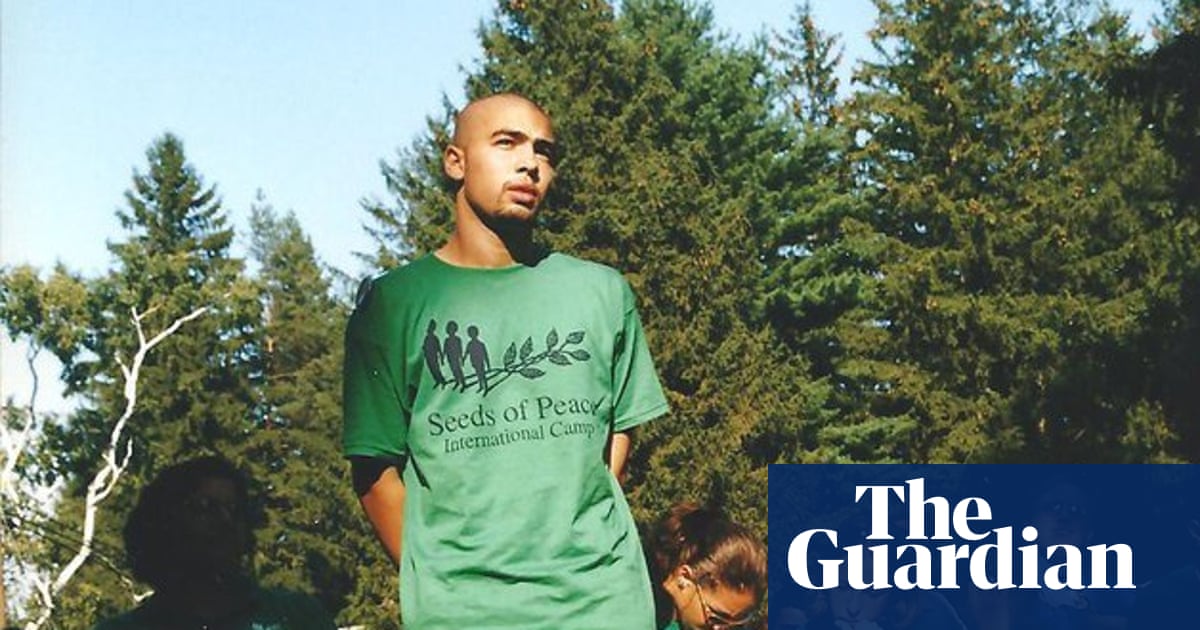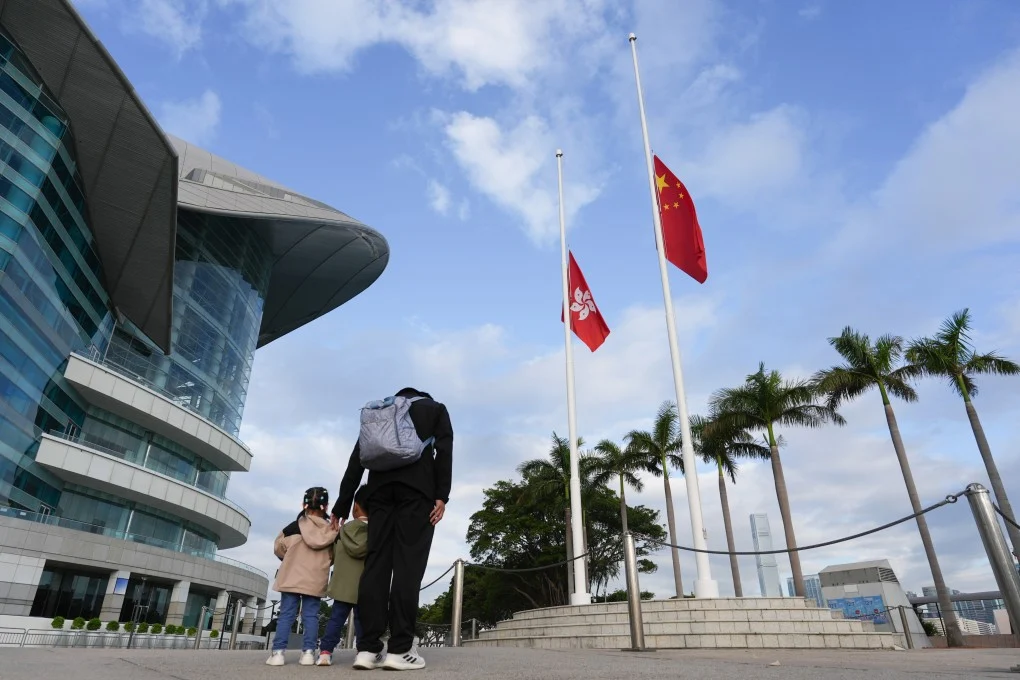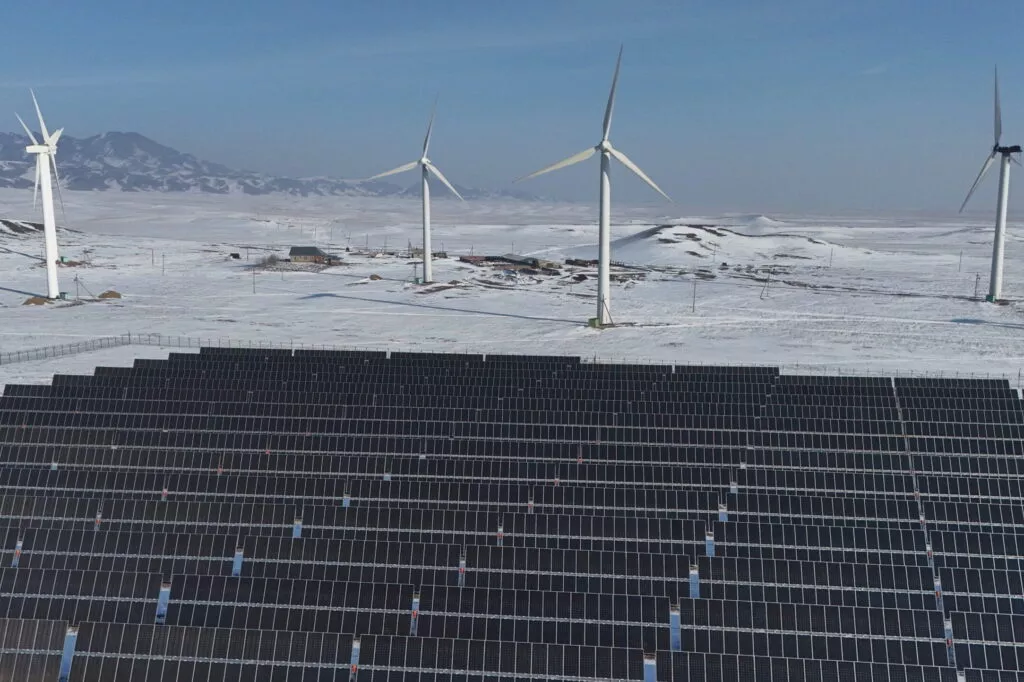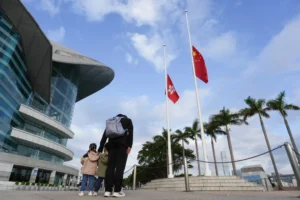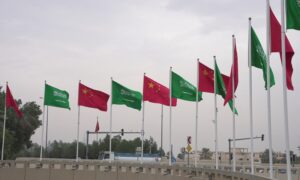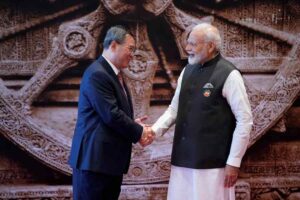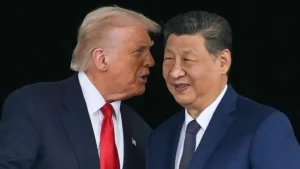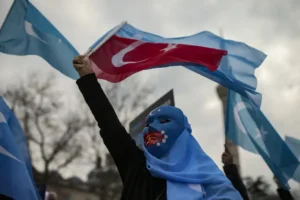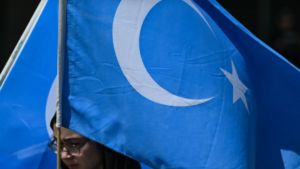In our teens, we dreamed of making peace in the Middle East. Then my friend was shot
On 11 May 2021, I was sitting with a small group in a cafe in southern Tel Aviv, studying Arabic. Our teacher, a Palestinian citizen of Israel, had been telling us that he and his pregnant Jewish wife kept getting turned down by landlords who would not rent their property to a “mixed” couple. We were almost at the end of the three-hour class when air raid sirens sounded. A few days earlier, missiles had been launched from Gaza into Israel, but this was the first time they had hit Tel Aviv. Beyond the fear of an airstrike, I had a sad, heavy feeling. I had recently returned to live in Israel after 15 years studying and working abroad. I remembered a time, in the mid-1990s, when I had believed that Israel was going to be different, more just and less violent. That belief now felt like a distant memory.
My faith in Israel’s future had been inspired by an experience I shared as a teenager with a group of extraordinary people. As we waited for the rocket fire to stop, I recalled one of those people in vivid detail, a person I have barely been able to talk about in my home country for more than 20 years. His name was Aseel Aslih.
When I first met Aseel, in 1997, he was 14, a Palestinian citizen of Israel from Arraba in the Galilee and I was 13, a Jew from the Mediterranean city of Ashdod (formerly the Palestinian village Isdud). We had been chosen as Israeli delegates to a summer camp in the US for teenagers from conflict areas. A few months before camp we both attended a preparatory seminar for the Israeli delegation. We didn’t become friends straight away. I was skinny, wore denim overalls and mostly hung out with girls. Aseel was slightly taller than me, physically bigger and already had facial hair. I felt uncomfortable around boys, not sure if they were going to comment on the way I spoke, which at the time I thought was too feminine. But I warmed to Aseel. His presence was engaging. He had a habit of tilting his head slightly to the side, his cheeks rising as he smiled. In conversation, he lowered his voice and narrowed his eyes, demanding attention.
Our delegation to the summer camp, which was called Seeds of Peace, had been selected by the Israeli ministry of education, which was looking for people with leadership skills and good English. While knowledge of a foreign language is often a product of privilege, neither Aseel nor I came from wealthy families. My father was a taxi driver and my mother worked for the Port Authority; Aseel’s father owned a small business and his mother was an educational counsellor. Our knack for languages and the gift of curiosity made us good candidates.
Seeds of Peace was founded by two Americans, John Wallach and Bobbie Gottschalk, in 1993, the year that the Oslo peace accords were signed between the Israeli government and the Palestine Liberation Organisation (PLO). The purpose of Seeds of Peace was to create bonds between young members of communities in conflict, and lay the groundwork for future understanding. Located in a rural part of Maine, the summer camp offered traditional activities like sports, art projects and talent shows; it also facilitated group dialogue sessions, in which campers from the different delegations talked about their hopes, fears and traumas with kids from enemy countries.
The year Aseel and I attended camp for the first time, 1997, there were 120 campers from Israel, Palestine, Jordan, Egypt, Tunisia, Morocco and Qatar, as well as the US. The camp was funded through a mix of corporate partnerships, individual donations and federal grants. It was the 90s: the cold war was officially over and the United States was the global leader, presenting itself to the Middle East as a hopeful messenger. We were young and we ate it up. To be put on a plane to go to summer camp – what could be more exciting?
When we arrived, the counsellors hugged us as we got off the bus. Camp felt safe, warm and welcoming. The closely packed bunk beds put us within arms’ reach of each other, and meeting rooms nested in the pines invited us to engage in conversation. Even the lake was called Pleasant. But conflict emerged on day two, when each of the delegations stood in front of their flag and sang their national anthem. Aseel and a fellow Palestinian citizen of Israel refused to sing the Israeli anthem. As Aseel told a friend, he could not relate to an anthem that started with the sentence, “As long as in the heart within, the Jewish soul yearns … our hope is not yet lost.” I was astonished by Aseel’s boldness. Being queer, I was always trying not to call attention to the ways in which I was different. And here was this kid from my delegation, only a year older than me, who acted the way he felt, who set himself aside from the pack. Not without jealousy, I began to admire him.
Not everything Aseel did was iconoclastic; he also had a fun-loving, silly side. In our first summer together, he co-wrote a song whose chorus was, “No food no food no food no food no food no food no food I hate waiting at the dining hall”. Aseel sang these lyrics with his co-writers at the camp’s talent show, exuding confidence. There was something about camp that made our young group shine. Being at Seeds of Peace felt like being part of history. Wallach told us every day that we were the future leaders of our peoples. I think Aseel and I shared the intoxicating excitement of seeing ourselves as agents of change.
Get the Guardian’s award-winning long reads sent direct to you every Saturday morning
In fact, Aseel was already effecting change. His unwillingness to sing the Israeli anthem was only the first in a series of actions that defied the Israeli delegation leaders’ expectations. Every group included three to five government officials who accompanied the kids. The officials made sure the students were well schooled in the official version of historic events. Israeli delegation leaders had party-line answers about the 1948 war, Palestinian refugees, settlements. But Aseel knew Palestinian history and insisted on telling it.
After our first summer at camp, a ministry of education official told Seeds of Peace that Aseel would not be permitted to return to camp with the Israeli delegation. So Seeds of Peace invited him in 1998 to participate as his own delegation. Aseel Aslih, a delegation of one. As a Jew whose family came from Algeria and Morocco, I had some idea of how hard it was to have an Arab identity in Israeli society. My grandmother Hajila went by her French name, Alice, while my father, Anjel Makhluf, went by the Jewish name Mordechai. It was easier that way. Aseel showed me, and the entire Israeli delegation, that it was possible to stand up for your identity.
That year, I got a glimpse of the connections that were possible between Palestinians and Israelis. Our relationships would always be complicated, but we had discovered we had a lot in common, and we had a lot to say. When tragedy hit those friendships, there was no way to talk about it. For long years of my life, the animated and hopeful interactions of those teenage years were overtaken by silence.
In the next few years, Aseel and I returned to camp every summer. We became members of a group of young leaders in the organisation. There was Tareq from the Jordanian delegation, whose family were Palestinian refugees. Aseel and I both looked up to Tareq, who was a couple of years older than us and already very worldly. There was Alia from the Palestinian delegation, an instant friend who I could joke around with for hours.
When the summer of 1997 ended, we returned to the Middle East. A triple suicide bombing in Jerusalem’s Ben Yehuda promenade had just killed four people. Israel was tense. Under the Oslo peace accords, Israel had withdrawn from Jericho, Gaza and most of Hebron. To some Israelis, these withdrawals were a betrayal of the country’s security interests; to others, they were a betrayal of a biblical pact with God. Religious and rightwing ideologues held mass protests against the Oslo accords. Labor prime minister Yitzhak Rabin, who had signed the Oslo accords, responded to the civil unrest and violence by severely limiting Palestinian movement from the West Bank and Gaza into Israel. This policy of restricting movement, which unfolded during the 90s, introduced new layers of permits and physical barriers. As children of the 80s, my generation of Israelis and Palestinians had been born into mostly segregated towns; the 90s made interaction between our communities even harder. To live in a Jewish town and have newly acquired Palestinian friends was highly unusual.
Facebook Twitter Aseel Aslih at a Seeds of Peace camp in the 1990s. Photograph: Bobbie Gottschalk
Returning home was especially challenging for one 15-year-old Palestinian girl from our 1997 Israeli delegation, who sent the Seeds of Peace magazine a letter entitled Caught Between Worlds, in which she wrote, “as a Palestinian living in Israel … I find it interesting but also difficult to have [these] two different sides to myself. Can these two worlds live together? Am I strange?” Aseel, also a Palestinian citizen of Israel, responded with an open letter of his own: “I don’t agree that you are caught … We don’t have to be caught; we can lead these two worlds.” Even in the confusing home environments we returned to, Aseel was ready to show us the way.
Even though I admired his courage, I was sometimes taken aback by what Aseel dared to say or do in public. In 1999, Seeds of Peace opened a centre in Jerusalem, and Aseel was asked to act as MC. In front of hundreds of people, Aseel performed a skit in which he “realised” that he wasn’t wearing Seeds of Peace’s signature green shirt and removed his clothes, only to reveal the green shirt and a pair of shorts underneath. Aseel was 6ft tall and athletic, his hairline already receding; he looked more like a man than a kid. But he was unafraid to make a fool of himself. I was cringing in the audience, embarrassed by what was, in retrospect, a hilarious performance. Seeds of Peace now had a place in Jerusalem, the Center for Coexistence, where Palestinians and Israelis could freely meet, and Aseel was the star of its opening night.
Seeds of Peace’s regional staff organised activities outside Jerusalem. In order for the teenagers to get around, the American staff hired a driver – Sami Al Jundi, a Jerusalem native who was fluent in the city’s languages, culture, people and roads. A few weeks after my group returned from camp in 1997, Sami picked us up in a Ford Transit and took us across checkpoints and borders. Every month after that, the young camp alumni would come up with a plan or an activity and Sami took us there – whether it was in Nahariya by the Lebanese border, or in the West Bank’s Beit Sahour. The American organisation had connections that navigated government and military bureaucracies, and Sami knew how to safely get us to our new friends. Driving in Sami’s Transit, boundaries between Jewish and Arab spaces shrank. Back then, I assumed that these boundaries would further diminish over time, and eventually disappear.
One weekend, when it was still possible for us to cross these borders, Sami and other staff brought friends to my house in Ashdod, including Tareq and others from Jordan. Aseel came down from the Galilee. The Jordanian guests and Aseel stayed the night. Aseel and I were the hosts in this country, so we gave the Jordanians the bedrooms. We shared my mother’s white couch. It was a long, deep couch; we could both fit if we lay head to toe. We fell asleep in front of the TV. At one point in the middle of the night, I woke up to the smell of Aseel’s feet. I got annoyed, and told myself that I would mention it in the morning. When morning came, Aseel donned the signature smile he had when he was about to say something controversial, and told me that the smell of my feet had woken him up. We laughed – and then we talked about South Park.
The decade that had started with peace treaties was spinning out of control. In 1995, prime minister Yitzhak Rabin had been murdered by a rightwing activist who wanted to disrupt the peace process. Seven years after the Oslo agreements, Labor’s new prime minister, Ehud Barak, decided that if he could not get a peace agreement signed within a year in office, no one could. His statement in July 2000 that there was “no partner” on the Palestinian side reaffirmed what anti-compromise activists in Israel had been saying all along: Jews must not trust Palestinians. A few months later, the right’s political veteran Ariel Sharon visited the al-Aqsa mosque compound in Jerusalem, which is also the holy grounds of the Jewish Temple Mount. Sharon knew that his presence there would stir Muslim leaders to calls to protect Jerusalem; his advisers later said in a documentary that they wanted to antagonise Palestinians and get media coverage in the run-up to the election. On 28 September 2000, the day of Sharon’s hour-long visit, scores of Palestinian protesters took to the streets and several threw stones at the politician’s entourage.
Within 48 hours, Palestinian protests escalated into road blockades, arson and sporadic attacks on Jews. They were met with force by police. High-ranking officers called for the use of rubber bullets, live ammunition and snipers. This was an unprecedented escalation in use of force against citizens. One Palestinian protester was filmed by a news crew telling a military sniper, “Why are you shooting us? These are not the occupied territories. We are citizens!” His words reflected the shock of a people who saw their country’s security forces use live weapons against them.
Facebook Twitter Israeli soldiers and Palestinian youths clash in Ramallah after Ariel Sharon’s visit to al-Aqsa compound, 28 September 2000. Photograph: Jamal Aruri/AFP/Getty Images
On 1 October 2000, three Palestinian citizens between the ages of 18 and 23 were shot dead. The following day, there was a rally outside Aseel’s home town, Arraba, in the Galilee. Aseel, who was 17 at the time, walked towards the protesters in his green Seeds of Peace shirt. His father, who was already there, said that Aseel stood at a distance from the crowd. He wasn’t carrying any kind of weapon. Suddenly, a police Jeep sped on to the scene. Four policemen jumped out. It was a common tactic at the time for police to make an example out of one protester in order to scare away the rest. Some of the policemen later testified that the fact Aseel was standing by himself made him look suspicious. I would guess that it also made him an easy target.
The policemen ran towards Aseel. When he tried to run, they chased him and one of them hit him in the back with his gun. Then they shot Aseel in the neck. He fell, face down. As he lay bleeding, the police walked away. When his cousin rushed to his side, he heard Aseel say: “They killed me.”
I was at home, standing next to the couch that Aseel and I had slept on, when Ned Lazarus, Seeds of Peace’s regional director, called. “Aseel is dead,” he said.
“What?” I said. “No. You’re wrong.”
I heard only muffled echoes of Ned’s words. The 17-year-old who defied authority, who wanted to lead both sides, who took his clothes off in front of hundreds of people to get a laugh, who was my friend. Gone.
Thirteen Palestinian men were killed by police in October 2000. Twelve of them were Israeli citizens and one was a man from Gaza who came to Israel to work. There was one Jewish-Israeli victim, who was killed as he was driving under a bridge and Palestinian protesters threw a rock on to his car. These events marked the beginning of the second intifada, a violent period that lasted four and a half years and took the lives of roughly 3,000 Palestinians and 1,000 Israelis.
To many in Israeli society, the events of October 2000 revealed that peace accords were an illusion: Palestinians had never wanted Jews around. The security offered by the state seemed fragile. Gun stores reported a spike in sales. On 7 October, an Israeli soldier from Tiberias was one of three kidnapped by the Lebanese organisation Hezbollah; Jewish people in his home town took to the streets, vandalised Arab-owned businesses and set fire to a mosque.
In my Jewish high school, I felt like no one wanted to hear about the death of my Palestinian friend. Even people who loved me found it hard to talk about Aseel. I wanted so desperately to bring Aseel into the conversation that one time, when I was 17, I brought a newspaper with his photo in it to a pub and waited for someone to ask about it. One friend did. We had a short conversation that faded away quickly. The fact that Aseel was a Palestinian killed by a police officer made the act of talking openly about his death political. During those times, a conversation about Aseel’s loss and my grief felt taboo.
At dinner with my family I brought up what happened to Aseel. My brother-in-law, who I love, asked: “What makes you think he was shot for no reason?” My brother-in-law’s family, like my mother’s, came from Algeria, which Jews fled during the Algerian war of independence in the middle of the 20th century. Our parents came to Israel because of its promise to be a safe haven for Jews. To acknowledge that a Palestinian had been illegally killed by a cop meant that the state was an unjust aggressor. It meant that we – my brother-in-law and I, our Jewish community in Israel – might not have right on our side. But Aseel was my friend, and my confusion quickly turned to anger. I banged my fist on the table and yelled at my brother-in-law for making assumptions about someone he had never met. I didn’t back down in the moment, but after that evening, I would talk about Aseel only around people with whom it felt safe to do so. I became more reserved, more careful.
While I was struggling to talk about the events of October 2000 in Jewish spaces, the victims’ families were protesting their sons’ deaths. Aseel’s father re-enacted for the TV news cameras how his son had been chased and shot, in a scene that I have rewatched on YouTube dozens of times. When I first watched this video, I imagined what it was like for Aseel in his final moments, how afraid he must have been. The older I got, the more I thought about what it was like for Aseel’s father to witness his son’s death, to go through the motions for the cameras. Israeli media got the message: here was an innocent victim. But it was a distorted one: it made out that Aseel the peace activist was the only innocent victim. Eventually, prime minister Barak appointed an official inquiry, the Or commission, to investigate the events surrounding the violent events of October 2000.
During the hearings, discrepancies emerged between the police testifying in Aseel’s case. When commission members challenged one of the policemen who chased Aseel, he said: “The fact that [our] testimonies don’t match only proves that we didn’t coordinate our stories.” This cynical argument, as if contradictory testimonies were a sign of credibility, didn’t surprise me. I heard this cynicism every time I tried to bring up Aseel. “It’s a shame he died, but you don’t know what really happened.” More and more, when the topic of October 2000 came up, I planned what I was going to say and how I was going to say it. I imagined people saying to me: “Did you really know him as well as you think?” I thought about who would hear me and who would find out what I had said. I surrendered to the fear of what other people might say, and shut myself behind a wall of silence.
In 2001, while the Or commission was in progress, I graduated from high school and was drafted into the military. After Aseel’s death, I could no longer believe in the wisdom and leadership of our generals, but still I could not imagine evading military service. It has been a deep part of Israeli culture my entire life, and the second intifada did not seem like a time to withdraw from service. In March 2002 alone, 135 Israelis were killed by suicide bombers. I joined the navy and, like most Jewish men, I served for three years, while my female friends served two. Many Palestinians found it offensive that their Israeli friends joined the military at all; soldiers can be tasked with carrying out state violence against Palestinians at checkpoints and in their own homes. Many friendships and connections disintegrated.
Facebook Twitter Aseel Aslih (seated far right) and Roy Cohen (seated third from right) at a Seeds of Peace camp in the 1990s. Photograph: Bobbie Gottschalk
The years of crossing borders in Sami Al Jundi’s van were long gone. Most of the American staff who had run the Jerusalem Seeds of Peace office, young professionals in their 20s and early 30s, left in the following years. The organisation talked about cancelling the activities that brought Palestinians and Israelis together. Sami, who had started as a driver and was now a staff member, was heartbroken. Before joining Seeds of Peace, he had been a prisoner in an Israel jail 30 minutes away from my home. In the 2011 memoir he co-wrote with Jen Marlowe, The Hour of Sunlight, Sami mentioned that at the age of 18, he and two of his friends assembled a bomb they intended to use against Israelis. The bomb blew up in Sami’s house and killed one of his friends. Sami was sent to prison for 10 years and got out in his late 20s. He dreamed of a different life for us. When Seeds of Peace considered closing the Jerusalem centre, Sami asked himself, “How would separating our community of peacemakers lead to achieving peace?” It was a rhetorical question to which he knew the answer. Eventually, Seeds of Peace shut down the centre whose opening Aseel hosted months before he was shot. The Center for Coexistence was no more. That same day, Seeds of Peace let Sami go.
Even as Seeds of Peace changed, the relationships formed there continued to offer me insight into how people outside Israel experienced the events of October 2000. Tareq, our friend from camp who grew up in Jordan, was at boarding school in Europe when he found out Aseel had been killed. I saw him at a Seeds of Peace alumni event in 2005, but I could not get myself to bring up Aseel. This was a different type of silence. We were Aseel’s friends, but I was Israeli and Tareq was Palestinian-Jordanian. I did not know if he wanted to talk about Aseel with me. I did not dare ask.
One of my other friends from camp, Alia, lived in the occupied West Bank. Israel’s changing policies made travel nearly impossible for her. After the second intifada, she had asked me to meet her in Jerusalem, wearing my soldier’s uniform. I knew it would make us both sad, but Alia was thoughtful about everything she did. I showed up in my khaki naval uniform, like she asked.
It was early winter. The streets of the French Hill neighbourhood were filled with stark mountain light. Alia and I were talking about relatively normal stuff – what she was planning to do after university, what I was planning to do after the military. We approached the building that used to be the Seeds of Peace centre. The site was now a painful reminder of the past: before the intifada, before they shut down the centre, before Aseel was killed.
The Or commission released its conclusions in 2003. The commission recommended disciplinary action against several high-ranking politicians and police officers for using live ammunition. However, the policemen who shot the victims fell under the jurisdiction of the department of internal police investigations. The police’s own investigation into October 2000 killings was less than rigorous. Eventually, in 2006, the head of the police’s internal investigations unit and the attorney general announced that none of the policemen involved in the October 2000 killings would be tried.
For years, I knew that people around me didn’t want to know what happened to Aseel. Now I knew that the justice system didn’t, either.
I left Israel in my 20s. Aseel’s death and the intifada were devastating. I had experienced through Seeds of Peace how big the world was, and I wanted to be part of it. But even as a neuroscience undergraduate in the US, I could not leave behind my roots: my topic of study was the effects of dialogue on Palestinians and Israelis. I dedicated my final thesis to Aseel. After school, I became a documentary film-maker and began making films about technology in London, Hong Kong and New York. I made a feature film about an American technologist who was fed up with humans and tried to build the first truly intelligent AI. When Machine of Human Dreams came out in 2016, I thought about Aseel, who – like me – spent hours of his youth in front of computers, exploring the internet. Had Aseel been alive, I wondered, would he have watched my film? Would he have liked it? Would we have still been friends?
Facebook Twitter Palestinian youths flee shots by Israeli troops near Gaza City, 1 October 2000. Photograph: Fayez Nureldine/AFP/Getty Images
In 2019, I moved back to Israel. Now, I am 37 and living in Tel Aviv. A few months ago, I attended a protest rally against evictions of Palestinian families from Jerusalem’s Sheikh Jarrah neighbourhood. We were standing in a drum circle with children dancing in the middle – not exactly a violent mob. Suddenly policemen in riot gear with guns appeared, and walked through our group, staring with hostile expressions as they passed close to us. I was afraid. I thought they might do to one of us what they did to Aseel. I wondered, does my face look more Jewish or more Arab to them? And if I am thinking about that, then how many others have avoided protesting alongside Palestinians for fear of getting caught up in violence?
In the two decades since October 2000, the cycle of land grabs, protest, violence and trauma has only worsened. I realised that in order to live in Israeli society again, I needed to talk about Aseel, our friendship and the painful silence surrounding his death. I contacted old friends with the idea of making a documentary. Almost none of my Palestinian friends had any interest in speaking on camera. One friend told me that, even if he trusted me with his story, his reputation could be damaged by being in an Israeli director’s film. Someone would inevitably call him out on social media as a normaliser of the occupation, of state violence, of the expansion of settlements. I realised that Palestinians had their own silences. In my film-making, and by picking up Arabic again, I am trying to find a voice to speak to Palestinians.
‘Look where we’ve got to – defeated and dominated’: my generation’s failure to liberate Palestine Read more
Silence has fallen in my relationship with Tareq. We haven’t spoken since the Seeds of Peace alumni event more than 15 years ago. He is now a businessperson in the United Arab Emirates. Although I’ve imagined talking to Tareq about Aseel many times, I have yet to come up with a way to start that conversation.
There is one person who breaks her silence in this story. Several years after we met for a walk in Jerusalem, Alia told me that she had asked me to wear my uniform that day so that she could see me as a soldier and finally let go of our friendship. Her plan did not have the intended effect: after that day in Jerusalem we had years of off-again, on-again communication, but we are now closer than ever. We talk every week. She married a man. I married one, too. In 2021, she managed to get a travel permit from Israeli authorities and we went to Jerusalem with her children. Looking at them, I was overwhelmed with the joy of seeing a loved one’s offspring; the ways in which they are similar to her, the ways in which they are new. But none of us has any idea when they’ll be able to travel again. This is not the dream that Aseel and I had shared. It is a violent reality in an unjust place, with brief moments of grace.
Some names have been changed
• Follow the Long Read on Twitter at @gdnlongread, listen to our podcasts here and sign up to the long read weekly email here.
